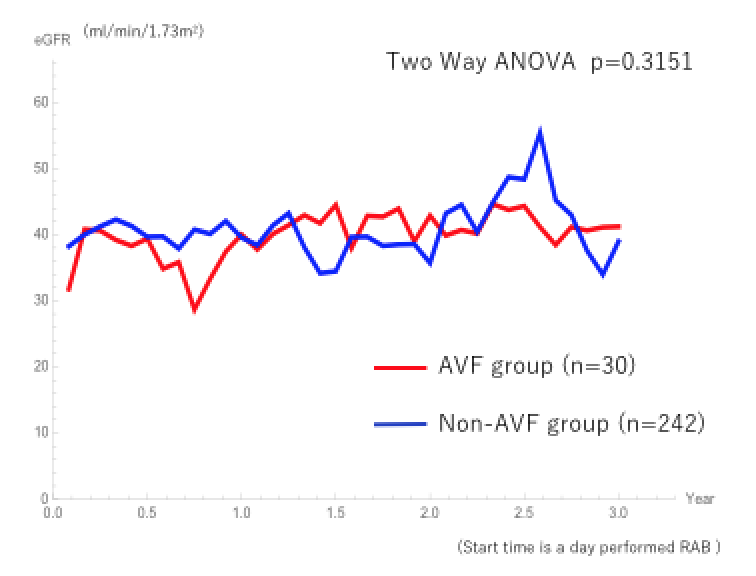Risk and Prognosis of Developing Procedural Complications in Renal Allograft Biopsy, Including AVF and DVT.
Kidney Surgery, Tokyo WOmen's Medical University, Shinjuku ku, Tokyo, Japan
Meeting: 2017 American Transplant Congress
Abstract number: C155
Keywords: Graft function
Session Information
Session Name: Poster Session C: Kidney Complications III
Session Type: Poster Session
Date: Monday, May 1, 2017
Session Time: 6:00pm-7:00pm
 Presentation Time: 6:00pm-7:00pm
Presentation Time: 6:00pm-7:00pm
Location: Hall D1
【Background】Percutaneous and ultrasound-guided renal allograft biopsy (RAB) is a gold standard procedure to evaluate renal allograft rejection. Because RAB is a relatively invasive test, we evaluated risk of its complications and prognoses of the graft thereafter.
【Method】This study was a single center retrospective cohort analysis of 325 RAB in 272 patients between 2013 and 2016. The biopsy was conducted percutaneously and ultrasound-guidedly, using 18G or 16G needle. We compared patient background between patients with and without complications of RAB.
【Results】 40 complications (12.3%) occurred in 325 RAB. They were 1 hematoma (0.3%), 7 hematuria (2.2%), 30 AVF in 30 patients (9.2%), and 2 deep vein thromboses (DVT; 0.62%). Comparison of patient background between those with complications (n=40) and the rest (n=232) revealed that there was a significant difference in graft weight (205±55g vs. 177±46g; p=0.023) and everolimus intake (p=0.047). In a hematoma case, a small mass developed around the graft which spontaneously disappeared in a few weeks. Hematuria was defined as more than 100/HPF RBC in urine sediment. Although one such a case presented macroscopic hematuria, all of them resolved spontaneously. Serum eGFR levels after biopsy were comparable between AVF group (n=30) and non-AVF group (n=242) with no graft loss by AVF.  Two patients with symptomatic DVT required re-admission and had high level of BMI (>30). Although one resulted in pulmonary embolism, they were resolved with anticoagulant therapy.
Two patients with symptomatic DVT required re-admission and had high level of BMI (>30). Although one resulted in pulmonary embolism, they were resolved with anticoagulant therapy.
【Conclusion】About one out of every 10 RAB was associated with a complication. Graft weight and everolimus intake were significant risk factors of complications with RAB. Although AVF was the most frequent one (9.2%), the graft function after developing it was comparable with that of non-AVF cases. However a life threatening complication of pulmonary embolism occurred in one case, probably due to compression around the allograft and bed rest for a few hours after the procedure. So we have to pay attention to the formation of thrombosis after RAB especially in an obese patient.
CITATION INFORMATION: Ide H, Iwadoh K, Nakajima I, Fuchinoue S. Risk and Prognosis of Developing Procedural Complications in Renal Allograft Biopsy, Including AVF and DVT. Am J Transplant. 2017;17 (suppl 3).
To cite this abstract in AMA style:
Ide H, Iwadoh K, Nakajima I, Fuchinoue S. Risk and Prognosis of Developing Procedural Complications in Renal Allograft Biopsy, Including AVF and DVT. [abstract]. Am J Transplant. 2017; 17 (suppl 3). https://atcmeetingabstracts.com/abstract/risk-and-prognosis-of-developing-procedural-complications-in-renal-allograft-biopsy-including-avf-and-dvt/. Accessed December 27, 2025.« Back to 2017 American Transplant Congress
